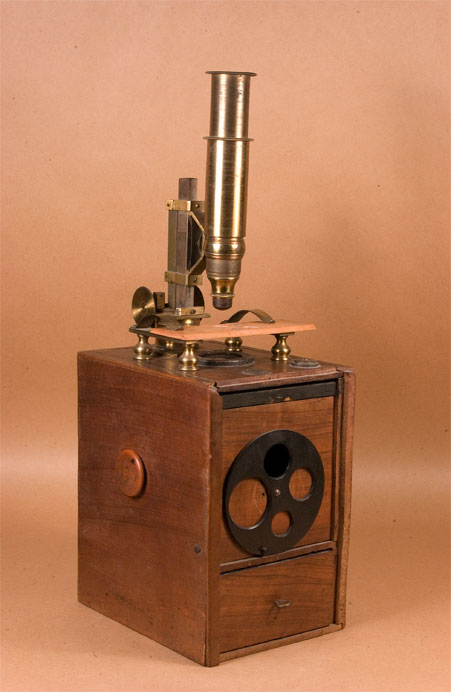 |
|||||
 |
 |
||||
 |
|||||
 |
 |
||||
Box Microscope (No. 67 ) |
||||||||||
 |
Age: c1780–1800 Made by: unknown Made in: Probably France* |
|||||||||
 |
||||||||||
|
Aquatic position
|
||||||||||
 |
||||||||||
|
Imaging
|
||||||||||
|
This style of instrument with a compound microscope mounted on a wooden box is referred to as a "Box Microscope", a type of microscope that was popular in France and Germany in the 18th Century. For this particular instrument, the box is mahogany with an accessory drawer at the base, an internal mirror, and a removable top. The microscope support pillar is fastened to the top of the box via a removable brass base. There are two spring-clip sample holders (also removable) on either side of a glass "condenser" lens. A mirror inside the box is mounted on a pivot; the angle of which is controlled by wooden knobs on both sides. In front is a rotating aperture stop with four openings. Curiously, two have the same diameter. There are two brass mounting sockets on the top surface, presumably for securing the bull's-eye epi-illuminating lens and one other accessory. A drawer holds a number additional accessories, including sample slides, two live-slides, and three brass devices presumably for holding or positioning samples. The microscope body tube is made of brass and is mounted to a pivot, which itself is mounted to the main support pillar (triangular in cross section). The microscope may be used in the vertical position or rotated to a horizontal, or "aquatic" position. Focus is by rack-and-pinion. The microscope has the usual three-lens optics system: eyepiece, field lens, objective. There are four objectives with this instrument, but only two still have glass lenses. Imaging is good with the two functional objectives yielding a total magnification of 125x and 400x. Supplied with this instrument are thirteen sample slides: Ten are softwood with 5 samples each; two are softwood with 4 samples each, and one is ivory with four samples. One of the wooden slides contains clues to the probable French origin of this microscope. The box is 12.3(w) x 15.5 (d) x 18.5cm (tall). The entire assembly is approximately 38cm tall. The microscope is similar to the French box microscope by Passemant in the Golub Collection. The support pillar, mount and focusing mechanism is identical to that found in an earlier (1725–1770) box microscope (#7288) housed in the Boerhaave Collection. Featured 06/2007 |
||||||||||